Assessing the Impact of Climate and Land-Use Changes on the Hydrologic Cycle Using the SWAT Model in the Mun River Basin in Northeast Thailand
Abstract
:1. Introduction
2. Materials and Methods
2.1. Study Area
2.2. Data Used
2.2.1. Hydro-Meteorological Data
2.2.2. Land-Use and Soil Data
2.3. Methodology
2.3.1. Hydrological Simulation Using the Soil and Water Assessment Tool (SWAT)
2.3.2. Future Hydrological Simulation under Climate Change and Land-Use Change Scenarios
3. Results and Discussion
3.1. Calibration and Validation of SWAT
3.2. Baseline Simulation of Hydrological Components
3.3. Projected Changes in Water Balance under Climate Change and Land-Use Change Scenarios
3.3.1. Water Balance Components
3.3.2. Projection of Flows and Soil Moisture
4. Conclusions
Supplementary Materials
Author Contributions
Funding
Data Availability Statement
Acknowledgments
Conflicts of Interest
References
- Jha, M.; Pan, Z.; Tackle, E.S.; Gu, R. Impacts of Climate Change on Streamflow in the Upper Mississippi River Basin: A Regional Climate Model Perspective. J. Geophys. Res. D Atmos. 2004, 109, D09105. [Google Scholar] [CrossRef]
- Osei, M.A.; Amekudzi, L.K.; Wemegah, D.D.; Preko, K.; Gyawu, E.S.; Obiri-Danso, K. The Impact of Climate and Land-Use Changes on the Hydrological Processes of Owabi Catchment from SWAT Analysis. J. Hydrol. Reg. Stud. 2019, 25, 100620. [Google Scholar] [CrossRef]
- Öztürk, M.; Copty, N.K.; Saysel, A.K. Modeling the Impact of Land Use Change on the Hydrology of a Rural Watershed. J. Hydrol. 2013, 497, 97–109. [Google Scholar] [CrossRef]
- Visweshwaran, R.; Ramsankaran, R.A.A.J.; Eldho, T.I.; Jha, M.K. Hydrological Impact Assessment of Future Climate Change on a Complex River Basin of Western Ghats, India. Water 2022, 14, 3571. [Google Scholar] [CrossRef]
- Brighenti, T.M.; Gassman, P.W.; Gutowski, W.J.; Thompson, J.R. Assessing the Influence of a Bias Correction Method on Future Climate Scenarios Using SWAT as an Impact Model Indicator. Water 2023, 15, 750. [Google Scholar] [CrossRef]
- Cuo, L.; Zhang, Y.; Gao, Y.; Hao, Z.; Cairang, L. The Impacts of Climate Change and Land Cover/Use Transition on the Hydrology in the Upper Yellow River Basin, China. J. Hydrol. 2013, 502, 37–52. [Google Scholar] [CrossRef]
- Wang, S.; Zhang, Z.; McVicar, T.R.; Guo, J.; Tang, Y.; Yao, A. Isolating the Impacts of Climate Change and Land Use Change on Decadal Streamflow Variation: Assessing Three Complementary Approaches. J. Hydrol. 2013, 507, 63–74. [Google Scholar] [CrossRef]
- World Economic Forum. The Global Risks Report 2023, 18th ed.; World Economic Forum: Geneva, Switzerland, 2023; ISBN 978-2-940631-36-0. [Google Scholar]
- Hartmann, D.L.B.T.-I.G. (Ed.) Chapter 6 Atmospheric General Circulation and Climate. In Global Physical Climatology; Academic Press: Cambridge, MA, USA, 1994; Volume 56, pp. 136–170. ISBN 0074-6142. [Google Scholar]
- Bates, B.C.; Kundzewicz, Z.W.; Wu, S.; Palutikof, J.P. (Eds.) Climate Change and Water. Technical Paper of the Intergovernmental Panel on Climate Change; IPCC Secretariat: Geneva, Switzerland, 2008; 210p. [Google Scholar]
- Chen, H.; Sun, J. Anthropogenic Warming Has Caused Hot Droughts More Frequently in China. J. Hydrol. 2017, 544, 306–318. [Google Scholar] [CrossRef]
- Sadhwani, K.; Eldho, T.I.; Jha, M.K.; Karmakar, S. Effects of Dynamic Land Use/Land Cover Change on Flow and Sediment Yield in a Monsoon-Dominated Tropical Watershed. Water 2022, 14, 3666. [Google Scholar] [CrossRef]
- Arnold, J.G.; Moriasi, D.N.; Gassman, P.W.; Abbaspour, K.C.; White, M.J.; Srinivasan, R.; Santhi, C.; Harmel, R.D.; Van Griensven, A.; Van Liew, M.W.; et al. SWAT: Model Use, Calibration, and Validation. Trans. ASABE 2012, 55, 1491–1508. [Google Scholar] [CrossRef]
- DHI MIKE SHE Volume 2: Reference Guide. Available online: https://manuals.mikepoweredbydhi.help/2017/Water_Resources/MIKE_SHE_Printed_V2.pd (accessed on 5 May 2020).
- Leavesley, G.H.; Lichty, R.W.; Troutman, B.M.; Saindon, L.G. Precipitation-Runoff Modeling System; User’s Manual; US Department of the Interior: Washington, DC, USA, 1983.
- Yira, Y.; Diekkrüger, B.; Steup, G.; Bossa, A.Y. Modeling Land Use Change Impacts on Water Resources in a Tropical West African Catchment (Dano, Burkina Faso). J. Hydrol. 2016, 537, 187–199. [Google Scholar] [CrossRef]
- Lindström, G.; Johansson, B.; Persson, M.; Gardelin, M.; Bergström, S. Development and Test of the Distributed HBV-96 Hydrological Model. J. Hydrol. 1997, 201, 272–288. [Google Scholar] [CrossRef]
- Usman, M.; Ndehedehe, C.E.; Farah, H.; Ahmad, B.; Wong, Y.; Adeyeri, O.E. Application of a Conceptual Hydrological Model for Streamflow Prediction Using Multi-Source Precipitation Products in a Semi-Arid River Basin. Water 2022, 14, 1260. [Google Scholar] [CrossRef]
- Reddy, N.N.; Reddy, K.V.; Vani, J.S.L.S.; Daggupati, P.; Srinivasan, R. Climate Change Impact Analysis on Watershed Using QSWAT. Spat. Inf. Res. 2018, 26, 253–259. [Google Scholar] [CrossRef]
- Liu, Y.; Xu, Y.; Zhao, Y.; Long, Y. Using SWAT Model to Assess the Impacts of Land Use and Climate Changes on Flood in the Upper Weihe River, China. Water 2022, 14, 2098. [Google Scholar] [CrossRef]
- Chen, C.; Gan, R.; Feng, D.; Yang, F.; Zuo, Q. Quantifying the Contribution of SWAT Modeling and CMIP6 Inputting to Streamflow Prediction Uncertainty under Climate Change. J. Clean. Prod. 2022, 364, 132675. [Google Scholar] [CrossRef]
- Arnold, J.G.; Srinivasan, R.; Muttiah, R.S.; Williams, J.R. Large Area Hydrologic Modeling And Assessment Part I: Model Development 1. JAWRA J. Am. Water Resour. Assoc. 1998, 34, 73–89. [Google Scholar] [CrossRef]
- Douglas-Mankin, K.R.; Srinivasan, R.; Arnold, J.G. Soil and Water Assessment Tool (SWAT) Model: Current Developments and Applications. Trans. ASABE 2010, 53, 1423–1431. [Google Scholar] [CrossRef]
- Borah, D.K.; Bera, M. Watershed-Scale Hydrologic And Nonpoint-Source Pollution Models: Review Of Applications. Trans. ASAE 2004, 47, 789–803. [Google Scholar] [CrossRef]
- Sharma, A.; Patel, P.L.; Sharma, P.J. Influence of Climate and Land-Use Changes on the Sensitivity of SWAT Model Parameters and Water Availability in a Semi-Arid River Basin. Catena 2022, 215, 106298. [Google Scholar] [CrossRef]
- Iqbal, M.; Wen, J.; Masood, M.; Masood, M.U.; Adnan, M. Impacts of Climate and Land-Use Changes on Hydrological Processes of the Source Region of Yellow River, China. Sustainability 2022, 14, 14908. [Google Scholar] [CrossRef]
- Lucas-Borja, M.E.; Carrà, B.G.; Nunes, J.P.; Bernard-Jannin, L.; Zema, D.A.; Zimbone, S.M. Impacts of Land-Use and Climate Changes on Surface Runoff in a Tropical Forest Watershed (Brazil). Hydrol. Sci. J. 2020, 65, 1956–1973. [Google Scholar] [CrossRef]
- Son, N.T.; Le Huong, H.; Loc, N.D.; Phuong, T.T. Application of SWAT Model to Assess Land Use Change and Climate Variability Impacts on Hydrology of Nam Rom Catchment in Northwestern Vietnam. Environ. Dev. Sustain. 2022, 24, 3091–3109. [Google Scholar] [CrossRef]
- De Girolamo, A.M.; Barca, E.; Leone, M.; Lo Porto, A. Impact of Long-Term Climate Change on Flow Regime in a Mediterranean Basin. J. Hydrol. Reg. Stud. 2022, 41, 101061. [Google Scholar] [CrossRef]
- Oduor, B.O.; Campo-Bescós, M.Á.; Lana-Renault, N.; Casalí, J. Effects of Climate Change on Streamflow and Nitrate Pollution in an Agricultural Mediterranean Watershed in Northern Spain. Agric. Water Manag. 2023, 285, 108378. [Google Scholar] [CrossRef]
- Du Plessis, J.A.; Kalima, S.G. Modelling the Impact of Climate Change on the Flow of the Eerste River in South Africa. Phys. Chem. Earth Parts A/B/C 2021, 124, 103025. [Google Scholar] [CrossRef]
- Ansa Thasneem, S.; Thampi, S.G.; Chithra, N.R. Uncertainties in Future Monsoon Flow Predictions in the Context of Projected Climate Change: A Study of the Chaliyar River Basin. Environ. Res. 2023, 222, 115301. [Google Scholar] [CrossRef]
- Jeon, D.J.; Ligaray, M.; Kim, M.; Kim, G.; Lee, G.; Pachepsky, Y.A.; Cha, D.-H.; Cho, K.H. Evaluating the Influence of Climate Change on the Fate and Transport of Fecal Coliform Bacteria Using the Modified SWAT Model. Sci. Total Environ. 2019, 658, 753–762. [Google Scholar] [CrossRef]
- Khadka, D.; Babel, M.S.; Shrestha, S.; Tripathi, N.K. Climate Change Impact on Glacier and Snow Melt and Runoff in Tamakoshi Basin in the Hindu Kush Himalayan (HKH) Region. J. Hydrol. 2014, 511, 49–60. [Google Scholar] [CrossRef]
- Yang, S.; Zhao, B.; Yang, D.; Wang, T.; Yang, Y.; Ma, T.; Santisirisomboon, J. Future Changes in Water Resources, Floods and Droughts under the Joint Impact of Climate and Land-Use Changes in the Chao Phraya Basin, Thailand. J. Hydrol. 2023, 620, 129454. [Google Scholar] [CrossRef]
- Trang, N.T.T.; Shrestha, S.; Shrestha, M.; Datta, A.; Kawasaki, A. Evaluating the Impacts of Climate and Land-Use Change on the Hydrology and Nutrient Yield in a Transboundary River Basin: A Case Study in the 3S River Basin (Sekong, Sesan, and Srepok). Sci. Total Environ. 2017, 576, 586–598. [Google Scholar] [CrossRef] [PubMed]
- Samal, D.R.; Gedam, S. Assessing the Impacts of Land Use and Land Cover Change on Water Resources in the Upper Bhima River Basin, India. Environ. Chall. 2021, 5, 100251. [Google Scholar] [CrossRef]
- El-Khoury, A.; Seidou, O.; Lapen, D.R.; Que, Z.; Mohammadian, M.; Sunohara, M.; Bahram, D. Combined Impacts of Future Climate and Land Use Changes on Discharge, Nitrogen and Phosphorus Loads for a Canadian River Basin. J. Environ. Manag. 2015, 151, 76–86. [Google Scholar] [CrossRef] [PubMed]
- Shrestha, S.; Bhatta, B.; Shrestha, M.; Shrestha, P.K.P.K. Integrated Assessment of the Climate and Landuse Change Impact on Hydrology and Water Quality in the Songkhram River Basin, Thailand. Sci. Total Environ. 2018, 643, 1610–1622. [Google Scholar] [CrossRef]
- Qi, S.; Sun, G.; Wang, Y.; Mcnulty, S.G.; Myers, J.A.M. Streamflow Response to Climate and Landuse Changes in a Coastal Watershed in North Carolina. Trans. ASABE 2009, 52, 739–749. [Google Scholar] [CrossRef]
- Kim, J.; Choi, J.; Choi, C.; Park, S. Impacts of Changes in Climate and Land Use/Land Cover under IPCC RCP Scenarios on Streamflow in the Hoeya River Basin, Korea. Sci. Total Environ. 2013, 452–453, 181–195. [Google Scholar] [CrossRef]
- Shooshtari, S.J.; Shayesteh, K.; Gholamalifard, M.; Azari, M.; Serrano-Notivoli, R.; López-Moreno, J.I. Impacts of Future Land Cover and Climate Change on the Water Balance in Northern Iran. Hydrol. Sci. J. 2017, 62, 2655–2673. [Google Scholar] [CrossRef]
- Jiang, J.; Wang, Z.; Lai, C.; Wu, X.; Chen, X. Climate and Landuse Change Enhance Spatio-Temporal Variability of Dongjiang River Flow and Ammonia Nitrogen. Sci. Total Environ. 2023, 867, 161483. [Google Scholar] [CrossRef]
- Dosdogru, F.; Kalin, L.; Wang, R.; Yen, H. Potential Impacts of Land Use/Cover and Climate Changes on Ecologically Relevant Flows. J. Hydrol. 2020, 584, 124654. [Google Scholar] [CrossRef]
- TMD the Climate of Thailand. Climatological Group, Meteorological Development Bureau, Meteorological Department. 2015. Available online: https://www.Tmd.Go.Th/En/Archive/Thailand_climate.Pdf (accessed on 16 November 2018).
- Prabnakorn, S.; Maskey, S.; Suryadi, F.X.; de Fraiture, C. Rice Yield in Response to Climate Trends and Drought Index in the Mun River Basin, Thailand. Sci. Total Environ. 2018, 621, 108–119. [Google Scholar] [CrossRef]
- Babel, M.S.; Agarwal, A.; Swain, D.K.; Herath, S. Evaluation of Climate Change Impacts and Adaptation Measures for Rice Cultivation in Northeast Thailand. Clim. Res. 2011, 46, 137–146. [Google Scholar] [CrossRef]
- Khadka, D.; Babel, M.S.; Collins, M.; Shrestha, S.; Virdis, S.G.P.P.; Chen, A.S. Projected Changes in the Near-Future Mean Climate and Extreme Climate Events in Northeast Thailand. Int. J. Climatol. 2022, 42, 2470–2492. [Google Scholar] [CrossRef]
- Fan, Y.; van den Dool, H. A Global Monthly Land Surface Air Temperature Analysis for 1948–Present. J. Geophys. Res. 2008, 113, D01103. [Google Scholar] [CrossRef]
- Khadka, D.; Babel, M.S.; Shrestha, S.; Virdis, S.G.P.; Collins, M. Multivariate and Multi-Temporal Analysis of Meteorological Drought in the Northeast of Thailand. Weather Clim. Extrem. 2021, 34, 100399. [Google Scholar] [CrossRef]
- Felix, M.L.; Jung, K. Impacts of Spatial Interpolation Methods on Daily Streamflow Predictions with SWAT. Water 2022, 14, 3340. [Google Scholar] [CrossRef]
- Haarsma, R.J.; Roberts, M.J.; Vidale, P.L.; Senior, C.A.; Bellucci, A.; Bao, Q.; Chang, P.; Corti, S.; Fučkar, N.S.; Guemas, V.; et al. High Resolution Model Intercomparison Project (HighResMIP~v1.0) for CMIP6. Geosci. Model Dev. 2016, 9, 4185–4208. [Google Scholar] [CrossRef]
- Maneechot, L.; Wong, Y.J.; Try, S.; Shimizu, Y.; Bharambe, K.P.; Hanittinan, P.; Ram-Indra, T.; Usman, M. Evaluating the Necessity of Post-Processing Techniques on D4PDF Data for Extreme Climate Assessment. Environ. Sci. Pollut. Res. 2023, 30, 102531–102546. [Google Scholar] [CrossRef]
- Kasem, S.; Thapa, G.B. Sustainable Development Policies and Achievements in the Context of the Agriculture Sector in Thailand. Sustain. Dev. 2012, 20, 98–114. [Google Scholar] [CrossRef]
- Wangpimool, W.; Pongput, K.; Tangtham, N.; Prachansri, S.; Gassman, P.W. The Impact of Para Rubber Expansion on Streamflow and Other Water Balance Components of the Nam Loei River Basin, Thailand. Water 2017, 9, 1. [Google Scholar] [CrossRef]
- Penny, J.; Djordjević, S.; Chen, A.S. Using Public Participation within Land Use Change Scenarios for Analysing Environmental and Socioeconomic Drivers. Environ. Res. Lett. 2021, 17, 025002. [Google Scholar] [CrossRef]
- Huang, Y.; Huang, J.L.; Liao, T.J.; Liang, X.; Tian, H. Simulating Urban Expansion and Its Impact on Functional Connectivity in the Three Gorges Reservoir Area. Sci. Total Environ. 2018, 643, 1553–1561. [Google Scholar] [CrossRef]
- Nepal, D.; Parajuli, P.B.; Ouyang, Y.; To, S.D.F.; Wijewardane, N. Assessing Hydrological and Water Quality Responses to Dynamic Landuse Change at Watershed Scale in Mississippi. J. Hydrol. 2023, 625, 129983. [Google Scholar] [CrossRef]
- Neitsch, S.L.; Arnold, J.G.; Kiniry, J.R.; Williams, J.R. Soil and Water Assessment Tool—Theoretical Documentation Version 2009. Texas Water Resources Institute, Texas A&M University. 2011. Available online: https://swat.tamu.edu/media/99192/swat2009-theory.pdf (accessed on 16 November 2018).
- Lin, B.; Chen, X.; Yao, H.; Chen, Y.; Liu, M.; Gao, L.; James, A. Analyses of Landuse Change Impacts on Catchment Runoff Using Different Time Indicators Based on SWAT Model. Ecol. Indic. 2015, 58, 55–63. [Google Scholar] [CrossRef]
- Zhou, F.; Xu, Y.; Chen, Y.; Xu, C.-Y.; Gao, Y.; Du, J. Hydrological Response to Urbanization at Different Spatio-Temporal Scales Simulated by Coupling of CLUE-S and the SWAT Model in the Yangtze River Delta Region. J. Hydrol. 2013, 485, 113–125. [Google Scholar] [CrossRef]
- Li, Z.; Liu, W.; Zhang, X.; Zheng, F. Impacts of Land Use Change and Climate Variability on Hydrology in an Agricultural Catchment on the Loess Plateau of China. J. Hydrol. 2009, 377, 35–42. [Google Scholar] [CrossRef]
- Fan, M.; Shibata, H. Simulation of Watershed Hydrology and Stream Water Quality under Land Use and Climate Change Scenarios in Teshio River Watershed, Northern Japan. Ecol. Indic. 2015, 50, 79–89. [Google Scholar] [CrossRef]
- Luo, M.; Liu, T.; Meng, F.; Duan, Y.; Bao, A.; Xing, W.; Feng, X.; De Maeyer, P.; Frankl, A. Identifying Climate Change Impacts on Water Resources in Xinjiang, China. Sci. Total Environ. 2019, 676, 613–626. [Google Scholar] [CrossRef]
- Allen, R.G.; Pereira, L.S.; Raes, D.; Smith, M. Crop Evapotranspiration: Guidelines for Computing Crop Water Requirements; FAO Irrigation and Drainage Paper 56; FAO: Rome, Italy, 1998. [Google Scholar]
- Martens, B.; Miralles, D.; Lievens, H.; van der Schalie, R.; de Jeu, R.; Férnandez-Prieto, D.; Beck, H.; Dorigo, W.; Verhoest, N. GLEAM v3: Satellite-Based Land Evaporation and Root-Zone Soil Moisture. Geosci. Model Dev. Discuss. 2016, 10, 1903–1925. [Google Scholar] [CrossRef]
- Miralles, D.G.; Holmes, T.R.H.; De Jeu, R.A.M.; Gash, J.H.; Meesters, A.G.C.A.; Dolman, A.J. Global Land-Surface Evaporation Estimated from Satellite-Based Observations. Hydrol. Earth Syst. Sci. 2011, 15, 453–469. [Google Scholar] [CrossRef]
- Rodell, M.; Houser, P.R.; Jambor, U.; Gottschalck, J.; Mitchell, K.; Meng, C.-J.; Arsenault, K.; Cosgrove, B.; Radakovich, J.; Bosilovich, M.; et al. The Global Land Data Assimilation System. Bull. Am. Meteorol. Soc. 2004, 85, 381–394. [Google Scholar] [CrossRef]
- Bi, H.; Ma, J.; Zheng, W.; Zeng, J. Comparison of Soil Moisture in GLDAS Model Simulations and in Situ Observations over the Tibetan Plateau. J. Geophys. Res. Atmos. 2016, 121, 2658–2678. [Google Scholar] [CrossRef]
- Abbaspour, K.C.; Rouholahnejad, E.; Vaghefi, S.; Srinivasan, R.; Yang, H.; Kløve, B. A Continental-Scale Hydrology and Water Quality Model for Europe: Calibration and Uncertainty of a High-Resolution Large-Scale SWAT Model. J. Hydrol. 2015, 524, 733–752. [Google Scholar] [CrossRef]
- Moriasi, D.N.; Arnold, J.G.; Van Liew, M.W.; Bingner, R.L.; Harmel, R.D.; Veith, T.L. Model Evaluation Guidelines for Systematic Quantification of Accuracy in Watershed Simulations. Trans. ASABE 2007, 50, 885–900. [Google Scholar] [CrossRef]
- Abbaspour, K.C.; Yang, J.; Maximov, I.; Siber, R.; Bogner, K.; Mieleitner, J.; Zobrist, J.; Srinivasan, R. Modelling Hydrology and Water Quality in the Pre-Alpine/Alpine Thur Watershed Using SWAT. J. Hydrol. 2007, 333, 413–430. [Google Scholar] [CrossRef]
- Chen, X.; Han, R.; Feng, P.; Wang, Y. Combined Effects of Predicted Climate and Land Use Changes on Future Hydrological Droughts in the Luanhe River Basin, China. Nat. Hazards 2022, 110, 1305–1337. [Google Scholar] [CrossRef]
- Narasimhan, B.; Srinivasan, R. Development and Evaluation of Soil Moisture Deficit Index (SMDI) and Evapotranspiration Deficit Index (ETDI) for Agricultural Drought Monitoring. Agric. For. Meteorol. 2005, 133, 69–88. [Google Scholar] [CrossRef]
- Giambelluca, T.W.; Mudd, R.G.; Liu, W.; Ziegler, A.D.; Kobayashi, N.; Kumagai, T.; Miyazawa, Y.; Lim, T.K.; Huang, M.; Fox, J.; et al. Evapotranspiration of Rubber (Hevea Brasiliensis) Cultivated at Two Plantation Sites in Southeast Asia. Water Resour. Res. 2016, 52, 660–679. [Google Scholar] [CrossRef]
- Lacombe, G.; Douangsavanh, S.; Vongphachanh, S.; Pavelic, P. Regional Assessment of Groundwater Recharge in the Lower Mekong Basin. Hydrology 2017, 4, 60. [Google Scholar] [CrossRef]
- Thompson, J.R.; Green, A.J.; Kingston, D.G. Potential Evapotranspiration-Related Uncertainty in Climate Change Impacts on River Flow: An Assessment for the Mekong River Basin. J. Hydrol. 2014, 510, 259–279. [Google Scholar] [CrossRef]
- Mangmeechai, A. Effects of Rubber Plantation Policy on Water Resources and Landuse Change in the Northeastern Region of Thailand. Geogr. Environ. Sustain. 2020, 13, 73–83. [Google Scholar] [CrossRef]
- Ougahi, J.H.; Karim, S.; Mahmood, S.A. Application of the SWAT Model to Assess Climate and Land Use/Cover Change Impacts on Water Balance Components of the Kabul River Basin, Afghanistan. J. Water Clim. Chang. 2022, 13, 3977–3999. [Google Scholar] [CrossRef]
- Tamm, O.; Maasikamäe, S.; Padari, A.; Tamm, T. Modelling the Effects of Land Use and Climate Change on the Water Resources in the Eastern Baltic Sea Region Using the SWAT Model. Catena 2018, 167, 78–89. [Google Scholar] [CrossRef]
- Li, C.; Fang, H. Assessment of Climate Change Impacts on the Streamflow for the Mun River in the Mekong Basin, Southeast Asia: Using SWAT Model. Catena 2021, 201, 105199. [Google Scholar] [CrossRef]
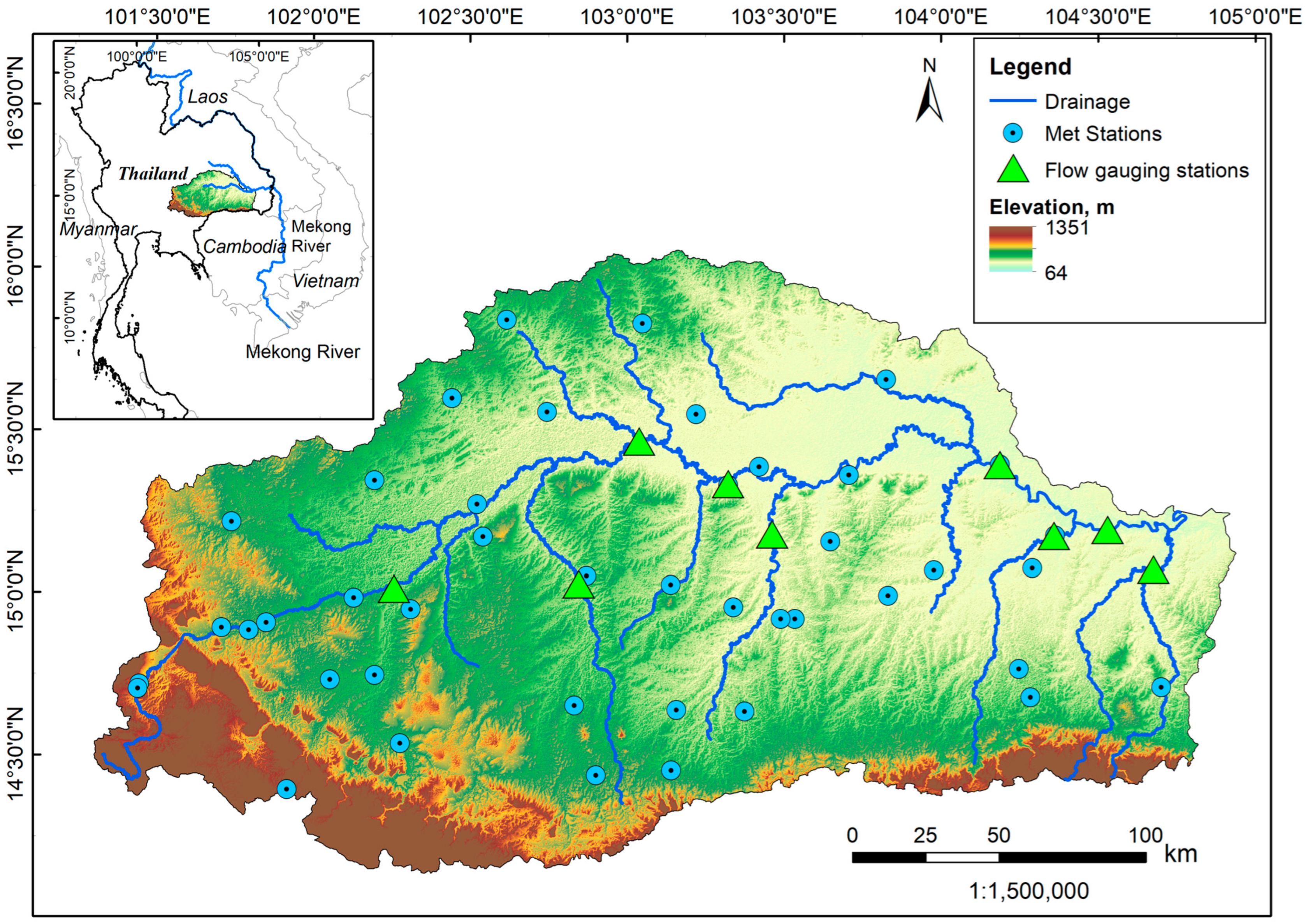
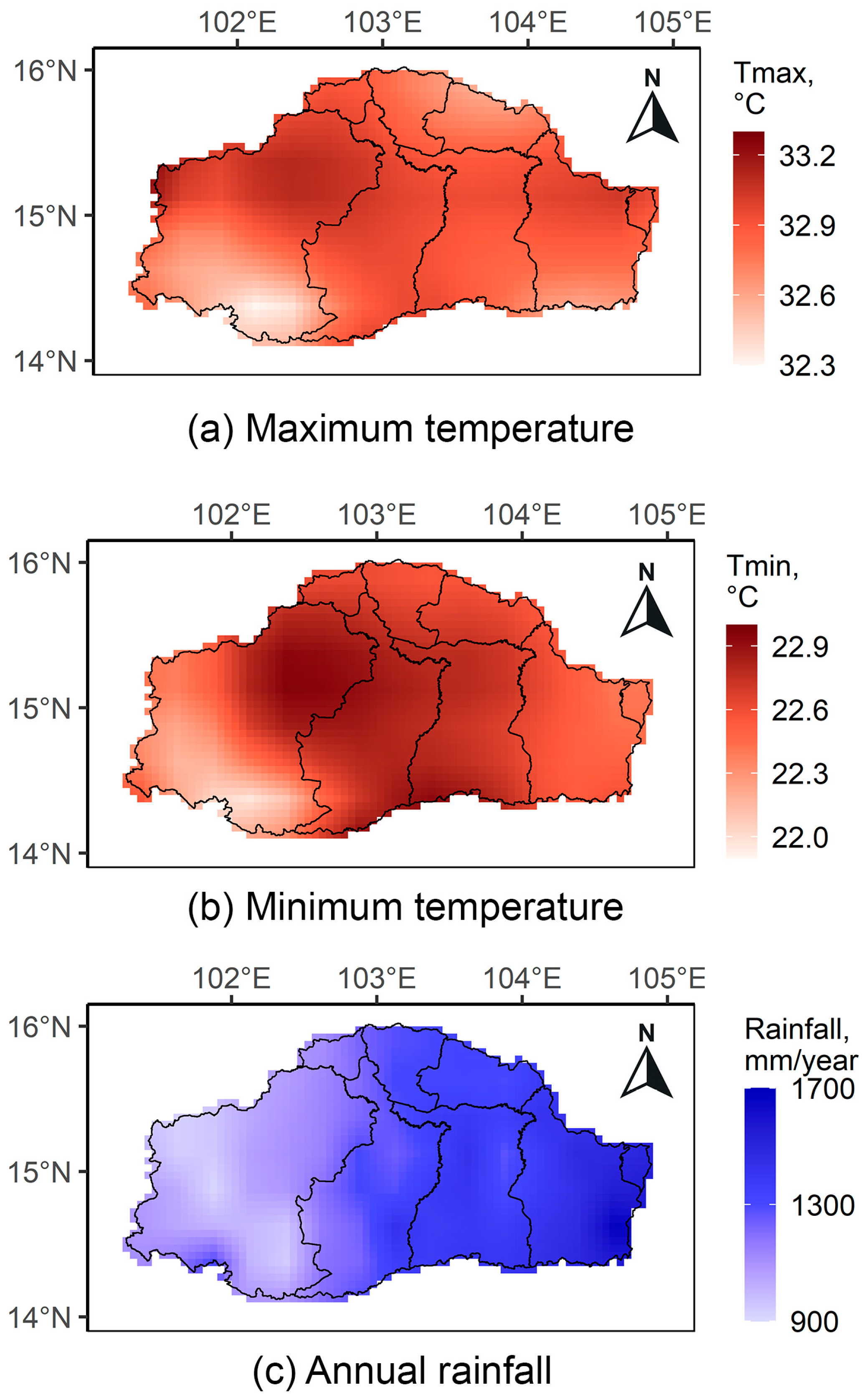
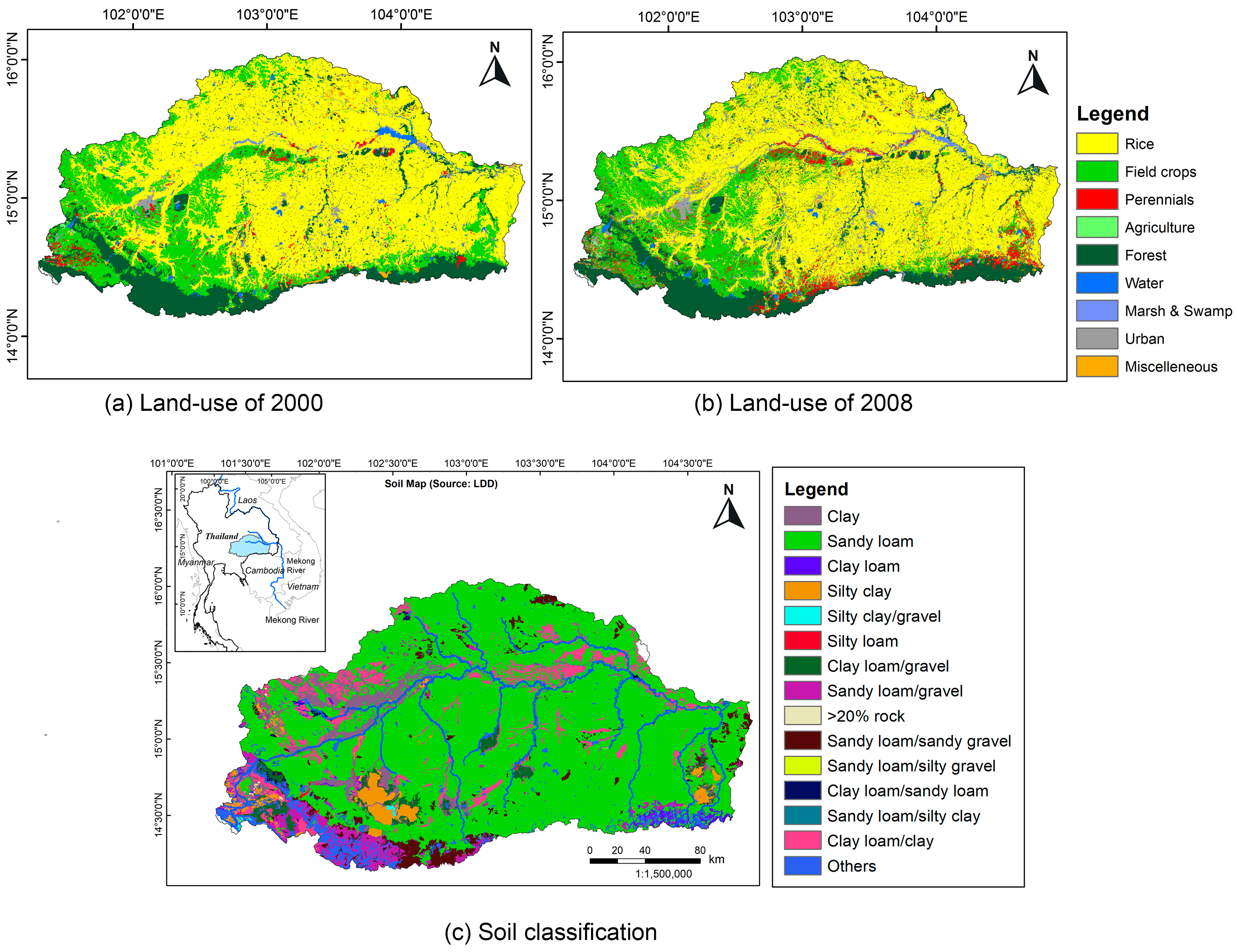
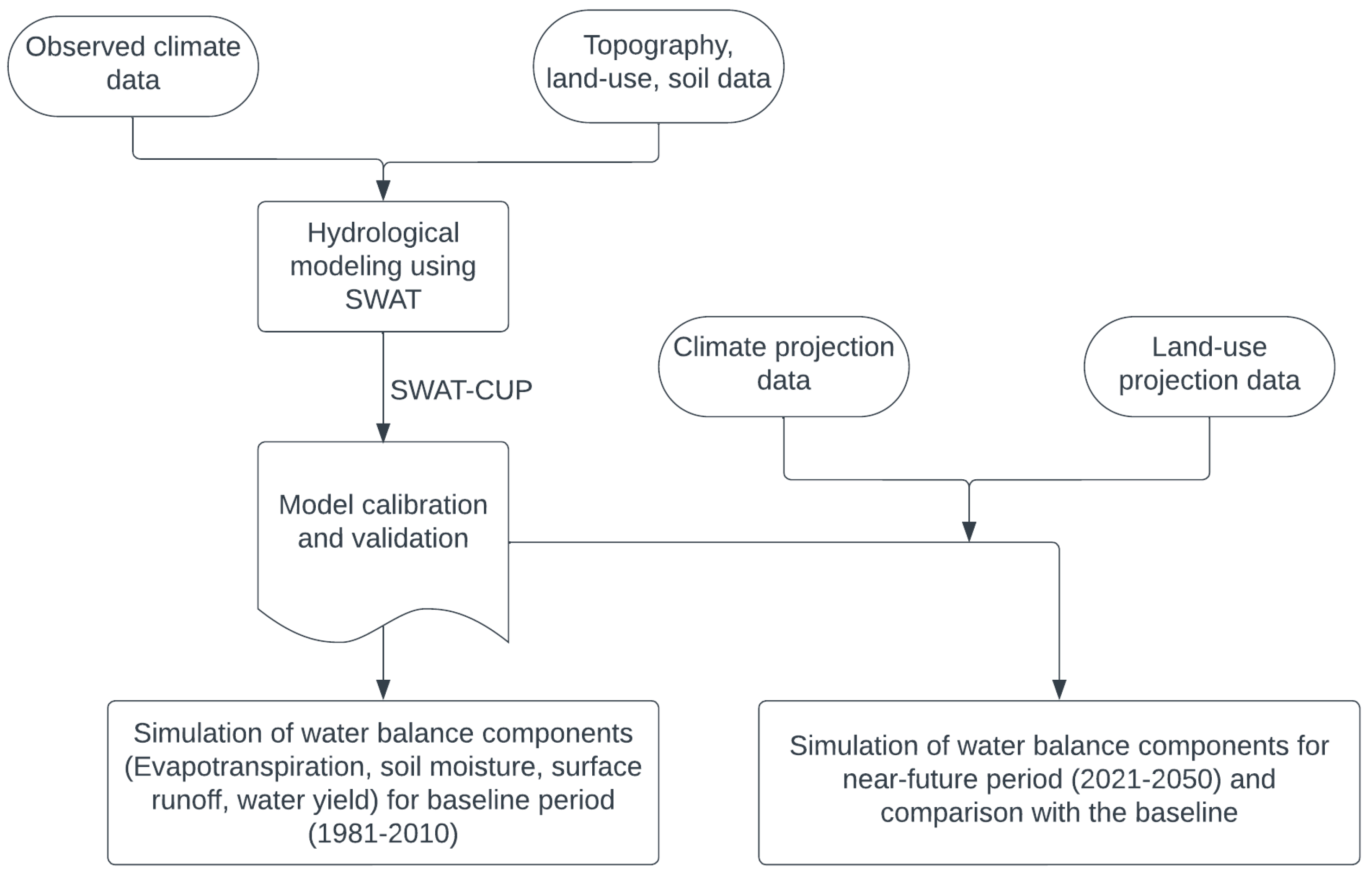
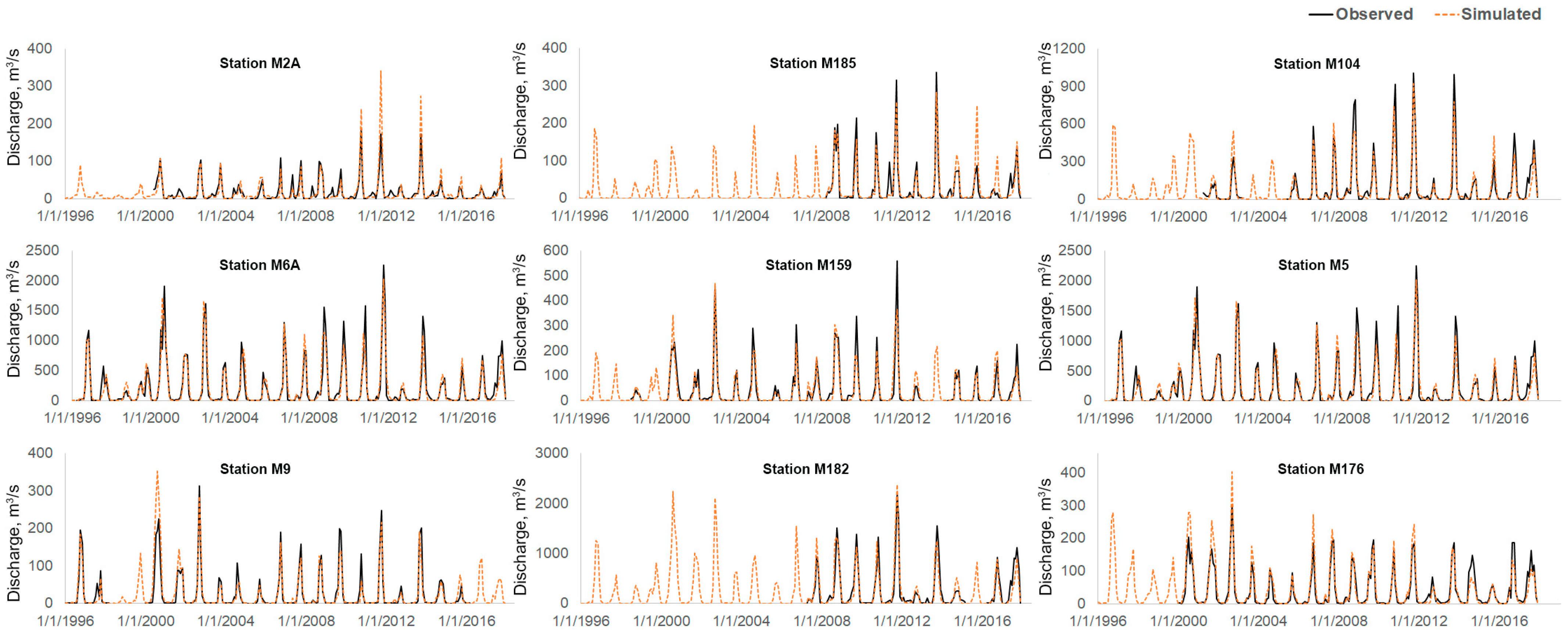


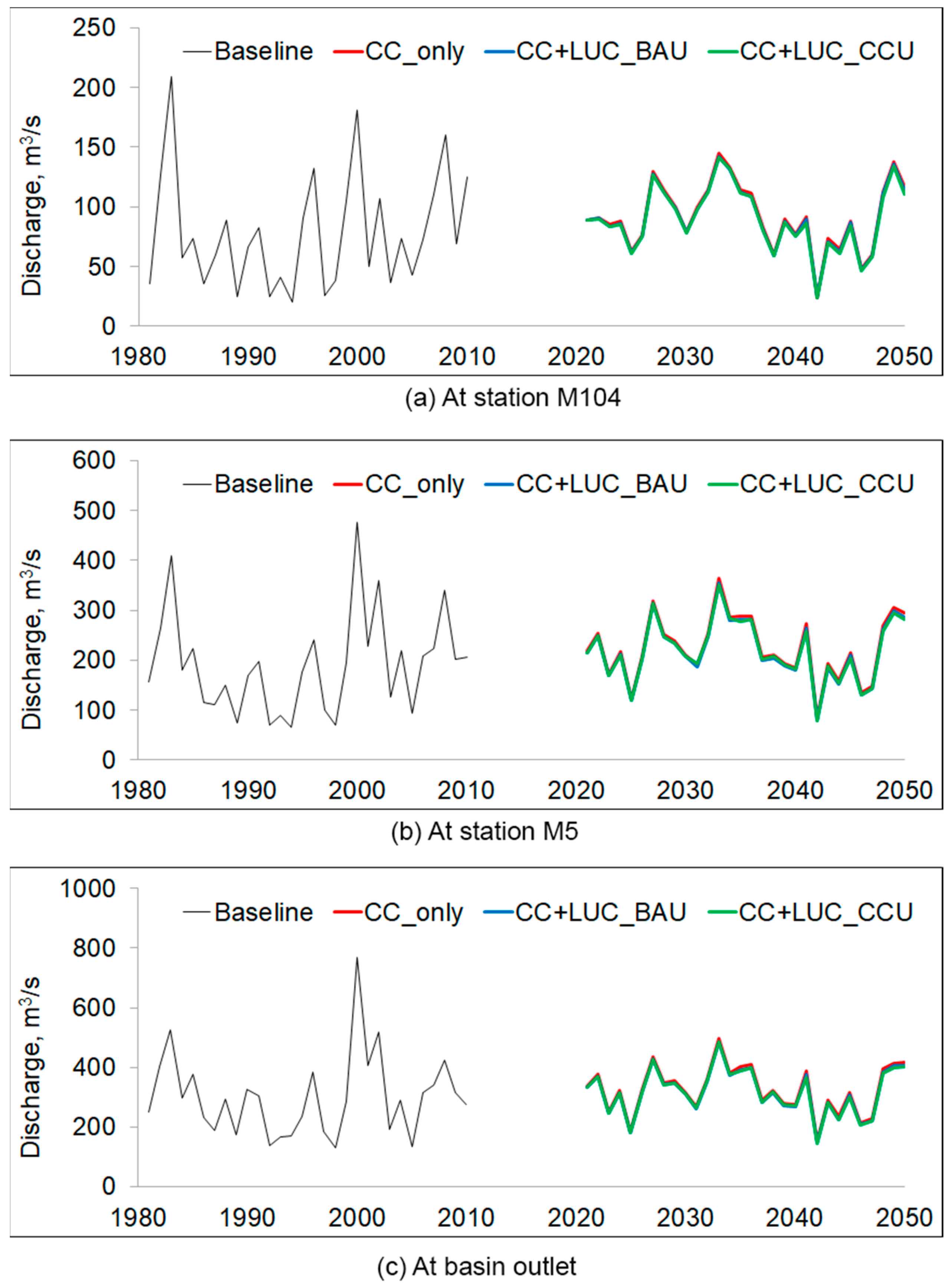

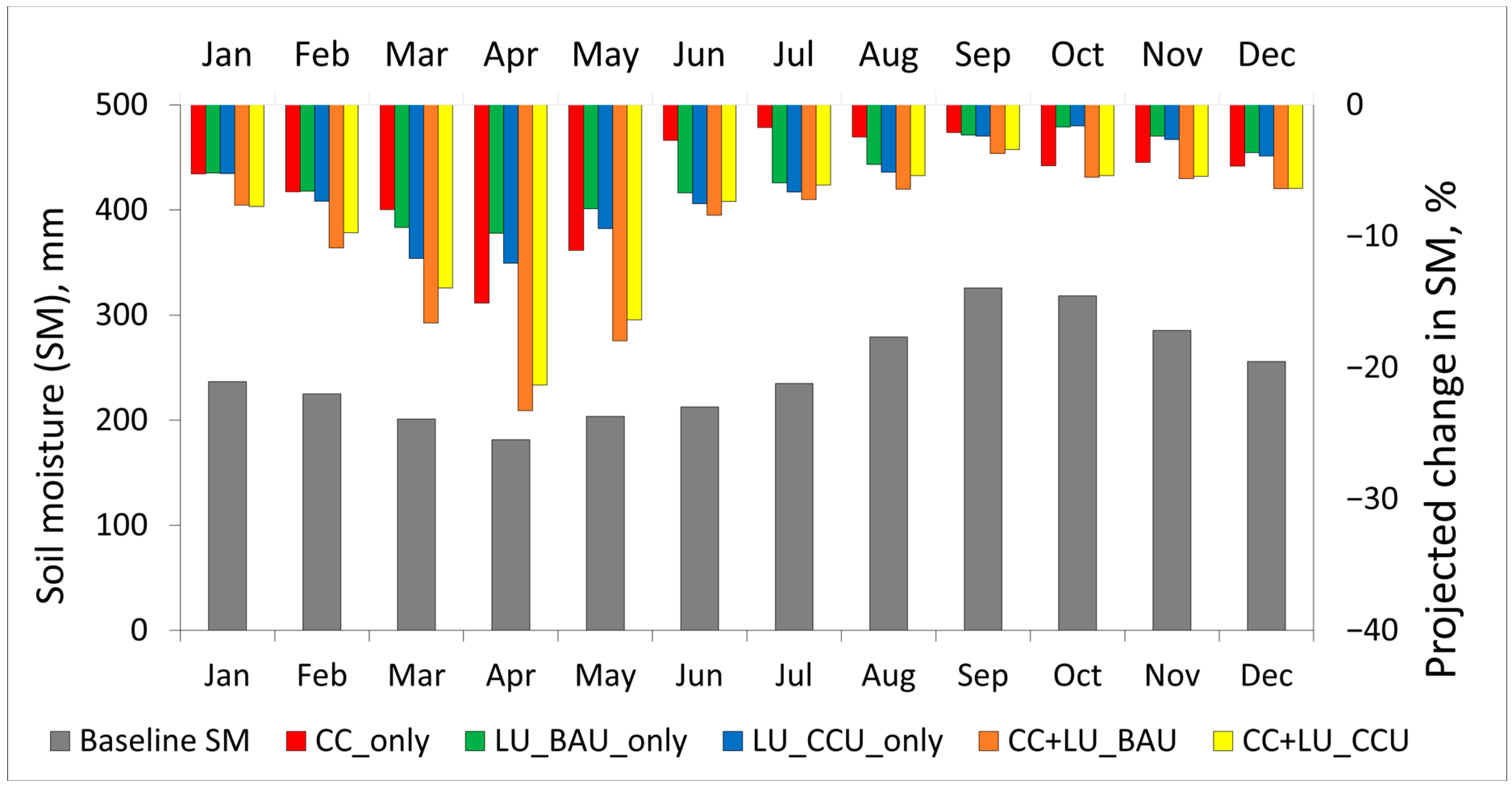
| S.N. | Land-Use Class | % of the Basin Area | |
|---|---|---|---|
| The Year 2000 | The Year 2008 | ||
| 1 | Rice | 60.2% | 55.5% |
| 2 | Field Crop | 18.2% | 14.3% |
| 3 | Perennials and Orchards (Rubber) | 1.7% | 4.9% |
| 4 | Agriculture (Others) | 0.1% | 0.9% |
| 5 | Forest | 12.2% | 12.5% |
| 6 | Water Bodies | 1.5% | 2.7% |
| 7 | Marsh and Swamp Land | 0.4% | 0.7% |
| 8 | Urban | 4.8% | 6.1% |
| 9 | Miscellaneous (Rangeland) | 0.9% | 2.5% |
| S.N. | Hydrological Station ID | Drainage Area (km2) | % of Land-Use Class | ||||||||
|---|---|---|---|---|---|---|---|---|---|---|---|
| Rice | Field Crop | Perennials and Orchards | Agriculture (Others) | Forest | Water Bodies | Marsh and Swamp Land | Urban | Miscellaneous | |||
| 1 | M176 | 2989 | 51.0% | 7.2% | 13.2% | 0.1% | 19.8% | 1.9% | 0.1% | 4.5% | 2.2% |
| 2 | M2A | 3137 | 14.0% | 35.8% | 7.1% | 4.6% | 19.3% | 1.6% | 0.2% | 12.9% | 4.5% |
| 3 | M9 | 3530 | 66.6% | 5.1% | 3.9% | 0.1% | 13.8% | 1.8% | 0.1% | 5.9% | 2.7% |
| 4 | M185 | 4610 | 25.9% | 16.8% | 7.1% | 0.2% | 41.5% | 2.6% | 0.1% | 4.3% | 1.5% |
| 5 | M159 | 4754 | 69.6% | 3.9% | 6.4% | 0.3% | 7.5% | 2.7% | 0.1% | 7.9% | 1.6% |
| 6 | M104 | 24,644 | 40.0% | 26.3% | 4.9% | 1.2% | 16.6% | 1.9% | 0.5% | 6.1% | 2.6% |
| 7 | M6A | 28,016 | 43.2% | 24.4% | 5.1% | 1.2% | 15.1% | 2.1% | 0.5% | 6.1% | 2.5% |
| 8 | M5 | 44,328 | 54.7% | 16.6% | 4.6% | 0.9% | 12.0% | 2.2% | 0.7% | 6.1% | 2.2% |
| 9 | M182 | 48,658 | 55.9% | 15.5% | 4.5% | 0.9% | 12.0% | 2.2% | 0.7% | 6.1% | 2.3% |
| S.N. | Hydrological Station ID | Projected Changes in the Land-Use | ||||||||
|---|---|---|---|---|---|---|---|---|---|---|
| Rice | Field Crop | Perennials and Orchards | Agriculture (Others) | Forest | Water Bodies | Marsh and Swamp Land | Urban | Miscellaneous | ||
| 1 | M176 | −16% (−30%) | 11% (2%) | 56% (20%) | 35% (36%) | −9% (45%) | 38% (38%) | 8% (−27%) | 21% (63%) | 5% (−2%) |
| 2 | M2A | −41% (−23%) | 24% (−1%) | −13% (−26%) | −24% (−21%) | −15% (12%) | 26% (26%) | −3% (−27%) | 16% (26%) | −12% (−1%) |
| 3 | M9 | −14% (−23%) | 28% (−8%) | 213% (75%) | 48% (44%) | −13% (61%) | 43% (43%) | 84% (58%) | 16% (62%) | −14% (−18%) |
| 4 | M185 | −26% (−34%) | 14% (−2%) | 73% (40%) | −46% (−39%) | −4% (11%) | 23% (23%) | −49% (−56%) | 13% (37%) | −26% (−28%) |
| 5 | M159 | −21% (−35%) | 137% (57%) | 97% (43%) | 33% (46%) | −4% (161%) | 41% (41%) | −4% (−31%) | 25% (77%) | 12% (8%) |
| 6 | M104 | −27% (−31%) | 34% (3%) | 36% (21%) | −23% (−20%) | −10% (42%) | 46% (45%) | 25% (2%) | 19% (45%) | −3% (2%) |
| 7 | M6A | −27% (−32%) | 38% (5%) | 40% (20%) | −26% (−22%) | −11% (53%) | 45% (45%) | 21% (−2%) | 20% (49%) | −2% (2%) |
| 8 | M5 | −21% (−31%) | 42% (7%) | 73% (36%) | −23% (−21%) | −11% (80%) | 49% (49%) | −13% (−40%) | 22% (60%) | 4% (6%) |
| 9 | M182 | −20% (−30%) | 42% (7%) | 83% (39%) | −20% (−19%) | −11% (80%) | 48% (48%) | −15% (−41%) | 21% (60%) | 3% (4%) |
| S.N. | Future Cases |
|---|---|
| Case1 | Climate change only (CC_only) |
| Case2 | Land-use change under BAU (LU_BAU_only) |
| Case3 | Land-use change under CCU (LU_CCU_only) |
| Case4 | Climate change and land-use change under BAU (CC+LUC_BAU) |
| Case5 | Climate change and land-use change under CCU (CC+LUC_CCU) |
| S.N. | Parameter | Descriptions | Initial Range | Calibrated Range | ||
|---|---|---|---|---|---|---|
| Min | Max | Min | Max | |||
| 1 | v__GW_DELAY.gw | Groundwater delay time (days) | 0 | 100 | 2 | 40 |
| 2 | v__GWQMN.gw | Threshold depth of water in the shallow aquifer required for return flow to occur (mm) | 0 | 1500 | 475 | 1250 |
| 3 | v__GW_REVAP.gw | Groundwater “revap” coefficient (-) | 0.02 | 0.2 | 0.016 | 0.16 |
| 4 | v__REVAPMN.gw | Threshold depth of water in the shallow aquifer for “revap” or percolation to the deep aquifer to occur (mm) | 0 | 100 | 300 | 777 |
| 5 | v__RCHRG_DP.gw | Deep aquifer percolation fraction (-) | 0 | 0.2 | 0.05 | 0.1 |
| 6 | v__CANMX.hru | Maximum canopy storage (mm) | 0 | 20 | 0 | 10 |
| 7 | v__ESCO.hru | Soil evaporation compensation factor (-) | 0 | 1 | 0.64 | 0.94 |
| 8 | v__OV_N.hru | Manning’s “n” value for overland flow | 0.05 | 0.2 | 0.12 | 0.16 |
| 9 | v__CH_N2.rte | Manning’s “n” value for the main channel | 0.014 | 0.1 | 0.015 | 0.025 |
| 10 | v__CH_N1.sub | Manning’s “n” value for the tributary channels | 0.014 | 0.1 | 0.015 | 0.025 |
| 11 | r__SOL_AWC.sol | Available water capacity in the soil layer (mm/mm soil) | −0.25 | 0.25 | 0.1 | 0.2 |
| 12 | r__SOL_K().sol | Saturated hydraulic conductivity | −0.25 | 0.25 | 0 | 0.15 |
| 13 | r__CN2.mgt | Initial SCS runoff curve number for moisture condition II (-) | −0.15 | 0.15 | −0.16 | −0.07 |
| Outlets | Calibration (2006–2017) | Validation (1996–2005) | ||||||||
|---|---|---|---|---|---|---|---|---|---|---|
| P-Factor | R-Factor | R2 | NSE | P-Bias (%) | P-Factor | R-Factor | R2 | NSE | P-Bias (%) | |
| M5 | 0.82 | 0.97 | 0.86 | 0.85 | 9.1 | 0.86 | 1.09 | 0.84 | 0.83 | −1.4 |
| M6A | 0.59 | 0.93 | 0.84 | 0.84 | 12.0 | 0.77 | 1.32 | 0.83 | 0.78 | −11.7 |
| M176 | 0.72 | 0.56 | 0.87 | 0.86 | 5.4 | 0.46 | 0.63 | 0.91 | 0.74 | −29.6 |
| M9 | 0.54 | 0.78 | 0.9 | 0.89 | 8.6 | 0.69 | 0.86 | 0.87 | 0.77 | −19.3 |
| M159 | 0.51 | 0.71 | 0.85 | 0.78 | 3.7 | 0.63 | 0.78 | 0.90 | 0.78 | 2.1 |
| M2A | 0.56 | 0.83 | 0.81 | 0.78 | 5.1 | 0.5 | 0.90 | 0.85 | 0.78 | 21.1 |
| M104 | 0.56 | 0.83 | 0.89 | 0.87 | 11.3 | - | - | - | - | - |
| M182 | 0.82 | 1.08 | 0.84 | 0.83 | 5.0 | - | - | - | - | - |
| M185 | 0.44 | 0.83 | 0.79 | 0.78 | −0.5 | - | - | - | - | - |
| Hydrologic Variables | Land Use | Number of Sub-Basins | Calibration | Validation |
|---|---|---|---|---|
| Evapotranspiration | Rice | 12 | 0.68–0.78 | - |
| Forest | 5 | 0.57–0.75 | - | |
| Field Crops | 3 | 0.30–0.57 | - | |
| Soil moisture | Rice | 12 | 0.69–0.86 | 0.53–0.80 |
| Forest | 5 | 0.74–0.87 | 0.59–0.79 | |
| Field Crops | 3 | 0.46–0.58 | 0.33–0.44 |
| Variables | In mm |
|---|---|
| Rainfall | 1233 |
| PET | 1830 |
| ET | 989 |
| Total aquifer recharge | 193 |
| Total groundwater storage | 48 |
| Deep aquifer recharge | 10 |
| Surface runoff, Q | 41 |
| Total water yield | 189 |
| S.N. | Future Cases | Projected Changes (%) in Near-Future Compared to the Baseline | ||||
|---|---|---|---|---|---|---|
| Rainfall | PET | ET | Surface Runoff | Water Yield | ||
| 1 | CC_only | 0.5 | 4.4 | 0.2 | 33 | 11 |
| 2 | LU_BAU_only | 0 | 0 | 1.0 | 7 | −5 |
| 3 | LU_CCU_only | 0 | 0 | 1.3 | 49 | −6 |
| 4 | CC+LUC_BAU | 0.5 | 4.4 | 0.5 | 38 | 8 |
| 5 | CC+LUC_CCU | 0.5 | 4.4 | 1.0 | 87 | 8 |
Disclaimer/Publisher’s Note: The statements, opinions and data contained in all publications are solely those of the individual author(s) and contributor(s) and not of MDPI and/or the editor(s). MDPI and/or the editor(s) disclaim responsibility for any injury to people or property resulting from any ideas, methods, instructions or products referred to in the content. |
© 2023 by the authors. Licensee MDPI, Basel, Switzerland. This article is an open access article distributed under the terms and conditions of the Creative Commons Attribution (CC BY) license (https://creativecommons.org/licenses/by/4.0/).
Share and Cite
Khadka, D.; Babel, M.S.; Kamalamma, A.G. Assessing the Impact of Climate and Land-Use Changes on the Hydrologic Cycle Using the SWAT Model in the Mun River Basin in Northeast Thailand. Water 2023, 15, 3672. https://doi.org/10.3390/w15203672
Khadka D, Babel MS, Kamalamma AG. Assessing the Impact of Climate and Land-Use Changes on the Hydrologic Cycle Using the SWAT Model in the Mun River Basin in Northeast Thailand. Water. 2023; 15(20):3672. https://doi.org/10.3390/w15203672
Chicago/Turabian StyleKhadka, Dibesh, Mukand S. Babel, and Ambili G. Kamalamma. 2023. "Assessing the Impact of Climate and Land-Use Changes on the Hydrologic Cycle Using the SWAT Model in the Mun River Basin in Northeast Thailand" Water 15, no. 20: 3672. https://doi.org/10.3390/w15203672
APA StyleKhadka, D., Babel, M. S., & Kamalamma, A. G. (2023). Assessing the Impact of Climate and Land-Use Changes on the Hydrologic Cycle Using the SWAT Model in the Mun River Basin in Northeast Thailand. Water, 15(20), 3672. https://doi.org/10.3390/w15203672






